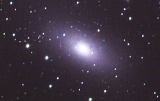
Messier 110
Encyclopedia
Messier 110 is a dwarf spheroidal galaxy
that is a satellite
of the Andromeda Galaxy
. M110 contains some dust and hints of recent star formation, which is unusual for dwarf elliptical galaxies in general.
never included the galaxy in his famous list, it was depicted by him, together with M32
, on a drawing of the Andromeda galaxy
; a label on the drawing indicates that Messier first observed NGC 205 on August 10, 1773. The galaxy was independently discovered by Caroline Herschel
on August 27, 1783; her brother William Herschel
described her discovery in 1785. The suggestion to assign the galaxy a Messier number was made by Kenneth Glyn Jones in 1967.
In 1999, Johnson and Modjaz discovered a nova
in M110.
Unlike M32, NGC205 does not show evidence for a supermassive black hole
at its center.
Dwarf spheroidal galaxy
Dwarf spheroidal galaxy is a term in astronomy applied to low luminosity galaxies that are companions to the Milky Way and to the similar systems that are companions to the Andromeda Galaxy M31...
that is a satellite
Satellite galaxy
A satellite galaxy orbits a larger galaxy due to gravitational attraction. Although a galaxy is made of a large number of objects which are not connected to each other, it has a center of mass, which represents a weighted average of the positions of each component object...
of the Andromeda Galaxy
Andromeda Galaxy
The Andromeda Galaxy is a spiral galaxy approximately 2.5 million light-years from Earth in the constellation Andromeda. It is also known as Messier 31, M31, or NGC 224, and is often referred to as the Great Andromeda Nebula in older texts. Andromeda is the nearest spiral galaxy to the...
. M110 contains some dust and hints of recent star formation, which is unusual for dwarf elliptical galaxies in general.
History
Although Charles MessierCharles Messier
Charles Messier was a French astronomer most notable for publishing an astronomical catalogue consisting of deep sky objects such as nebulae and star clusters that came to be known as the 110 "Messier objects"...
never included the galaxy in his famous list, it was depicted by him, together with M32
Messier 32
Messier 32 is a dwarf elliptical galaxy about 2.65 million light-years away in the constellation Andromeda. M32 is a satellite galaxy of the famous Andromeda Galaxy and was discovered by Le Gentil in 1749. M32 measures only 6.5 ± 0.2 kly in diameter at the widest point...
, on a drawing of the Andromeda galaxy
Andromeda Galaxy
The Andromeda Galaxy is a spiral galaxy approximately 2.5 million light-years from Earth in the constellation Andromeda. It is also known as Messier 31, M31, or NGC 224, and is often referred to as the Great Andromeda Nebula in older texts. Andromeda is the nearest spiral galaxy to the...
; a label on the drawing indicates that Messier first observed NGC 205 on August 10, 1773. The galaxy was independently discovered by Caroline Herschel
Caroline Herschel
Caroline Lucretia Herschel was a German-British astronomer, the sister of astronomer Sir Friedrich Wilhelm Herschel with whom she worked throughout both of their careers. Her most significant contribution to astronomy was the discovery of several comets and in particular the periodic comet...
on August 27, 1783; her brother William Herschel
William Herschel
Sir Frederick William Herschel, KH, FRS, German: Friedrich Wilhelm Herschel was a German-born British astronomer, technical expert, and composer. Born in Hanover, Wilhelm first followed his father into the Military Band of Hanover, but emigrated to Britain at age 19...
described her discovery in 1785. The suggestion to assign the galaxy a Messier number was made by Kenneth Glyn Jones in 1967.
In 1999, Johnson and Modjaz discovered a nova
Nova
A nova is a cataclysmic nuclear explosion in a star caused by the accretion of hydrogen on to the surface of a white dwarf star, which ignites and starts nuclear fusion in a runaway manner...
in M110.
Unlike M32, NGC205 does not show evidence for a supermassive black hole
Supermassive black hole
A supermassive black hole is the largest type of black hole in a galaxy, in the order of hundreds of thousands to billions of solar masses. Most, and possibly all galaxies, including the Milky Way, are believed to contain supermassive black holes at their centers.Supermassive black holes have...
at its center.

